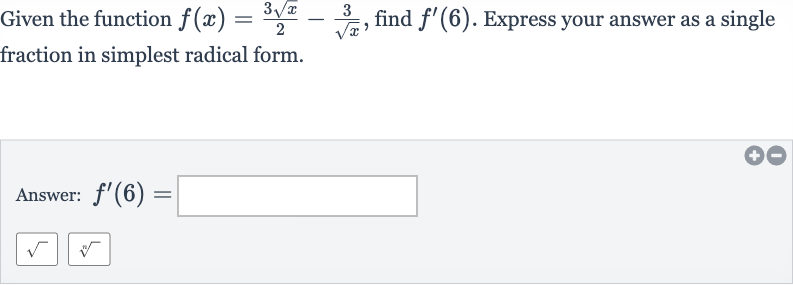AI tutor
Welcome to Bytelearn!
Let’s check out your problem:

Given the function , find . Express your answer as a single fraction in simplest radical form.Answer:
Full solution
Q. Given the function , find . Express your answer as a single fraction in simplest radical form.Answer:
- Find Derivative of Function: First, we need to find the derivative of the function . To do this, we will use the power rule for differentiation. The square root of can be written as , so the function becomes .
- Differentiate First Term: Now, let's differentiate the first term . Using the power rule, the derivative of is , so the derivative of is .
- Differentiate Second Term: Next, we differentiate the second term . Again, using the power rule, the derivative of is .
- Combine Derivatives: Combining the derivatives of both terms, we get the derivative of the function , which is .
- Evaluate at : Now we need to evaluate the derivative at . Substituting with , we get .
- Simplify Square Root and Cube Root: To simplify, we calculate the square root and the cube root of . The square root of is , and the cube root of is . So, .
- Find Common Denominator: We can simplify the expression further by finding a common denominator. The common denominator for and is . So, we multiply the first term by to get the common denominator. f'(\(6) = \left(\frac{}{}\right)\left(\frac{\sqrt{}}{\sqrt{}}\right)\left(\frac{}{\sqrt{}}\right) + \left(\frac{}{}\right)\left(\frac{}{(\sqrt{})^}\right) = \frac{\sqrt{}}{\sqrt{}^} + \left(\frac{}{}\right)\left(\frac{}{\sqrt{}^}\right).
- Combine Terms with Common Denominator: Simplifying the denominators, we have and . So,
- Simplify Fraction: Now, we combine the terms over a common denominator, which is . To do this, we multiply the second term by to get the common denominator. .
- Factor Out from Numerator: Adding the two fractions together, we get . This is the derivative of the function evaluated at .
- Factor Out from Numerator: Adding the two fractions together, we get . This is the derivative of the function evaluated at .Finally, we simplify the fraction by factoring out a from the numerator. . We can simplify this further by dividing both the numerator and the denominator by . .
